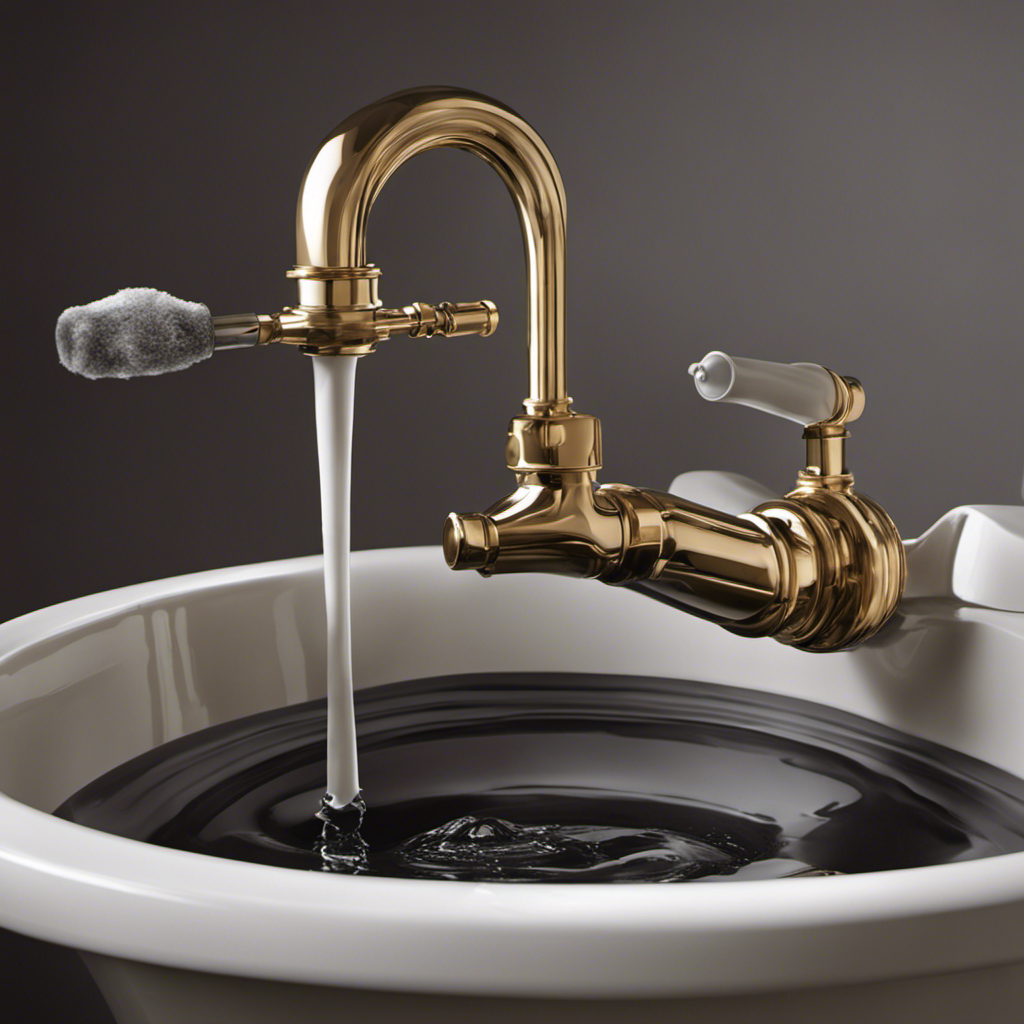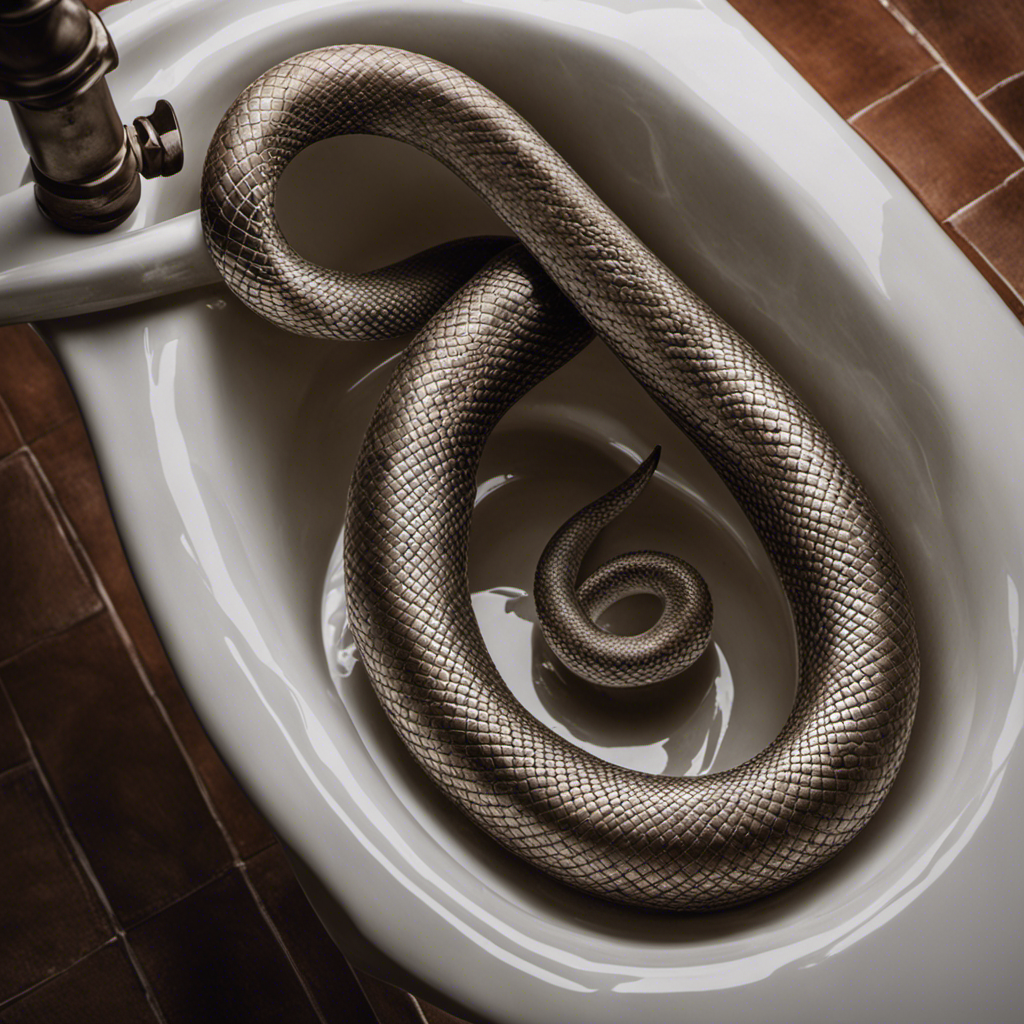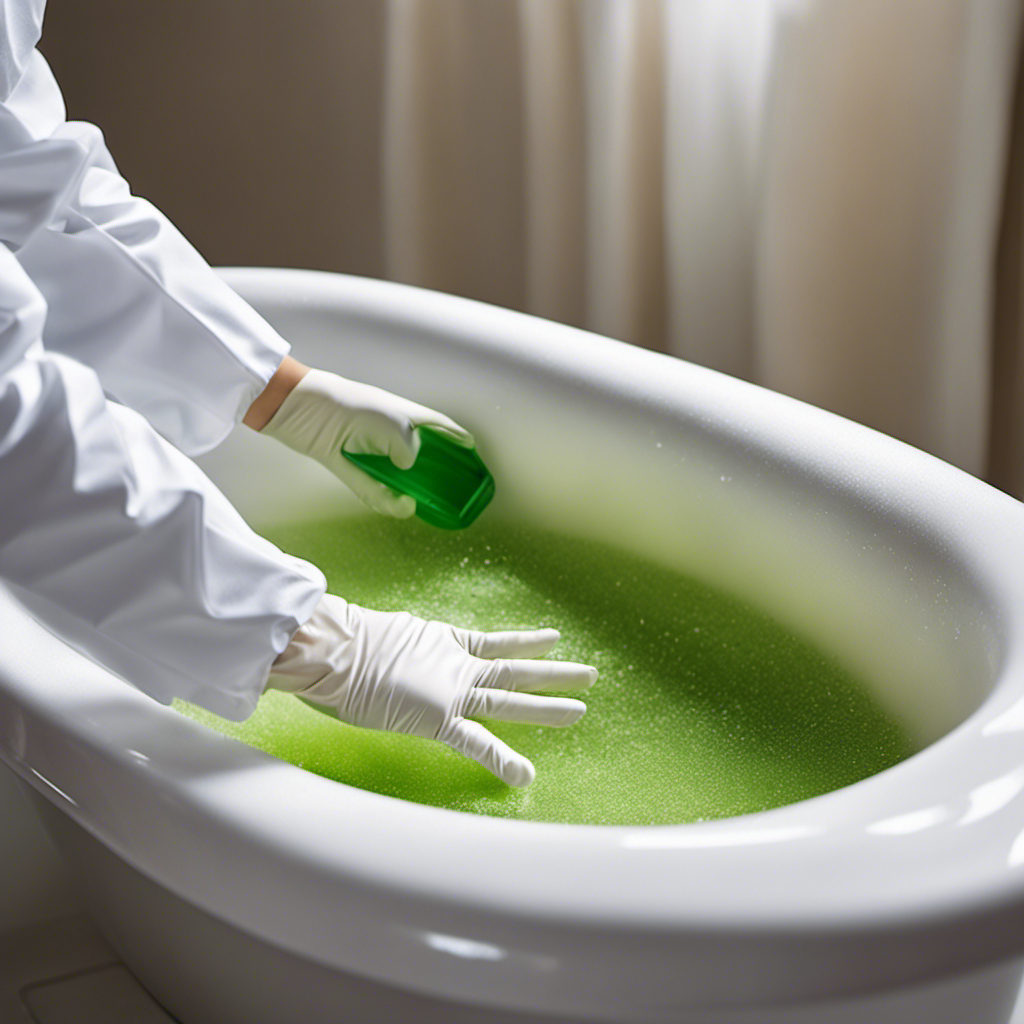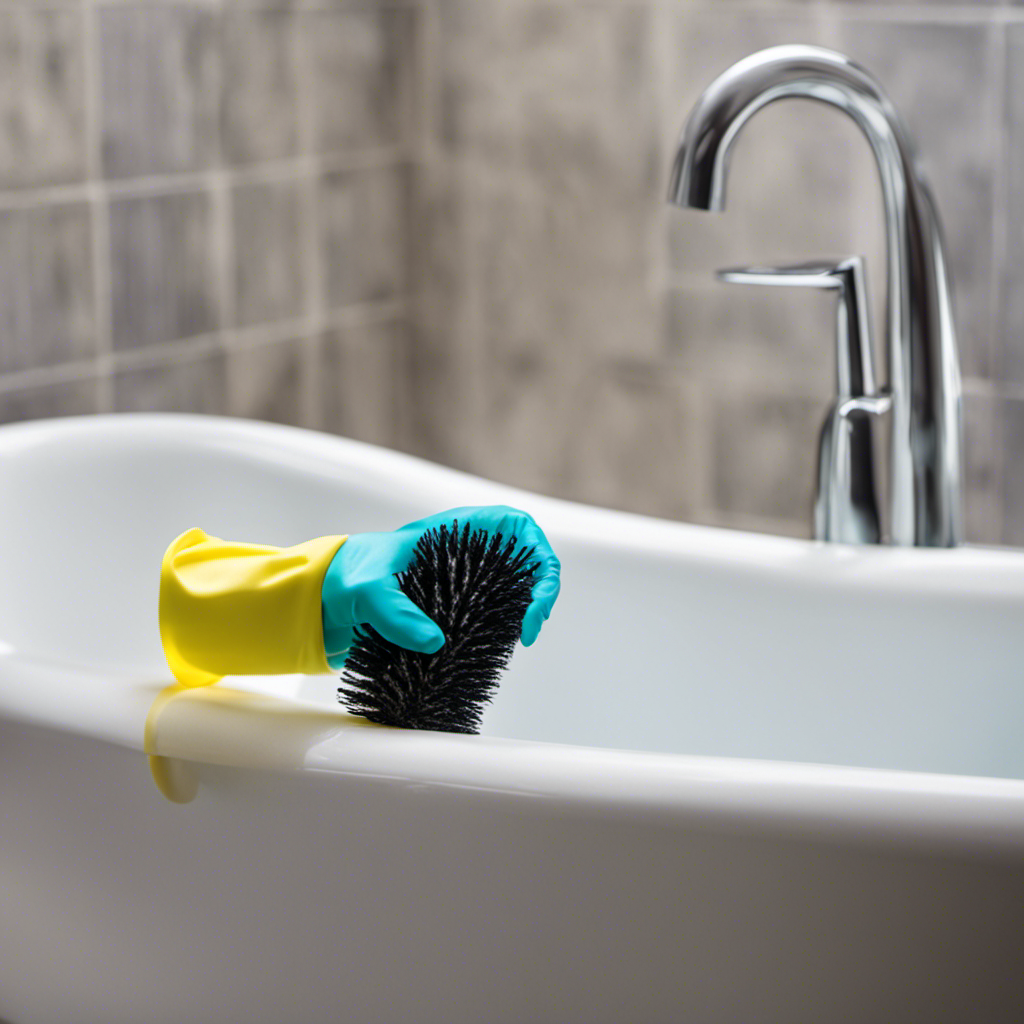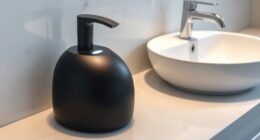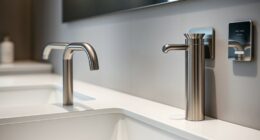Have you ever found yourself ankle-deep in water while taking a shower because your bathtub drain is clogged? Don’t worry, we’ve got you covered!
In this article, we will show you step-by-step how to unclog your bathtub using simple tools and natural methods. No need to call a plumber or spend a fortune on expensive products.
By following our practical tips and techniques, you’ll have your bathtub drain flowing smoothly again in no time.
Key Takeaways
- Regularly clean the drain and remove built-up residue to prevent clogs.
- Use a drain strainer or hair catcher to catch hair and debris and prevent clogs.
- Avoid pouring grease and oil down the drain to prevent blockages.
- If the plunger doesn’t work, try alternative methods like using a drain snake or a mixture of baking soda and vinegar.
Identifying the Cause of the Clog
To figure out what’s causing the clog, you should start by removing the drain cover. This will give you access to the drain pipe and allow you to see if there are any obvious blockages.
The most common causes of bathtub clogs are hair, soap scum, and mineral buildup. Hair tends to get caught in the drain, especially if there is no hair trap installed. Soap scum and mineral buildup can accumulate over time and create a thick layer that restricts water flow.
Regular maintenance is important to prevent clogs from occurring. By regularly cleaning the drain and removing any debris, you can prevent the buildup of hair, soap scum, and minerals. Additionally, using a hair trap or drain cover can help catch hair before it goes down the drain and causes a clog.
Tools and Materials Needed for Unclogging
You’ll need a plunger and a drain snake to clear the clog. Here’s what you’ll need to gather before you get started:
-
Plunger: This tool is essential for unclogging most bathtub drains. Make sure you have a plunger with a flat bottom, specifically designed for sinks and tubs.
-
Drain Snake: A drain snake is a flexible tool that helps remove stubborn clogs. It has a long wire coil that can be inserted into the drain to break up and remove debris.
-
Rubber Gloves: It’s important to protect your hands from any chemicals or debris that may be present in the drain. Wear rubber gloves to keep your hands clean and safe.
Removing Hair and Debris From the Drain
To prevent future clogs in your bathtub drain, there are a few simple steps you can take.
First, make sure to use a drain strainer or hair catcher to catch any hair or debris before it goes down the drain.
Additionally, it is important to regularly clean out the drain and remove any built-up residue.
If you do encounter a clog, using drain cleaning products can be an effective solution. Just be sure to follow the instructions carefully and avoid using harsh chemicals that could damage your pipes.
Preventing Future Clogs
One way to prevent future clogs is by using a drain strainer. This simple tool can catch hair and debris before it goes down the drain, keeping your bathtub drain clean and clog-free.
Here are three additional tips for maintaining your bathtub drain:
-
Regularly clean the drain strainer: Remove the strainer and clean it thoroughly to ensure it remains effective in trapping hair and debris. A buildup of gunk can reduce its efficiency.
-
Avoid pouring grease and oil down the drain: Grease and oil can solidify and cause blockages in your drain. Dispose of them in a separate container or wipe them off with a paper towel before rinsing.
-
Use a drain cleaner periodically: Even with a drain strainer, small particles can still accumulate over time. Using a drain cleaner once a month can help dissolve any buildup and keep your drain flowing smoothly.
Using Drain Cleaning Products
If you’re looking for a quick and easy solution, using a drain cleaning product can help remove any stubborn clogs. However, it’s important to be aware of alternative solutions and take the necessary safety precautions.
Before reaching for a drain cleaning product, try using a plunger or a plumbing snake to see if you can dislodge the clog manually. If these methods don’t work, then you can consider using a drain cleaning product.
When using these products, always make sure to follow the instructions carefully and wear protective gloves and goggles. Avoid mixing different chemicals and never use a plunger or snake after using a drain cleaning product, as it can cause dangerous chemical reactions.
Remember to keep the area well-ventilated and never leave the product unattended. Taking these safety precautions will ensure a successful and safe unclogging experience.
Using a Plunger to Unclog the Bathtub
When it comes to unclogging your bathtub, using a plunger can be an effective technique. To ensure its effectiveness, make sure to create a tight seal between the plunger and the drain.
If the plunger doesn’t work, there are alternative methods you can try, such as using a drain snake or a mixture of baking soda and vinegar.
Lastly, to prevent future clogs, consider using a drain strainer to catch hair and debris, and regularly flush your drains with hot water to keep them clean and clear.
Plunger Technique Effectiveness
To effectively unclog your bathtub, grab a plunger and firmly press it against the drain. This is a tried and true method that can often solve minor clogs. However, if the plunger technique doesn’t work, don’t worry. There are alternative methods you can try to get your bathtub flowing freely again.
Here are three options to consider:
-
Use a drain snake: This flexible tool can reach deep into the drain to remove stubborn clogs. Simply insert it into the drain and twist it to break up the blockage.
-
Try a natural solution: Mix equal parts baking soda and vinegar, and pour it down the drain. Let it sit for a few minutes, then flush with hot water. The chemical reaction can help dissolve clogs.
-
Call a professional plumber: If all else fails, don’t hesitate to seek professional help. Plumbers have the tools and expertise to tackle even the toughest clogs.
Alternative Unclogging Methods
One effective option for clearing stubborn clogs is using a drain snake. However, if you don’t have a drain snake or prefer alternative solutions, there are DIY remedies you can try. Here are some practical and effective methods to unclog your bathtub:
-
Baking Soda and Vinegar: Mix 1/2 cup of baking soda with 1/2 cup of vinegar and pour it down the drain. Let it sit for an hour, then flush with hot water.
-
Boiling Water: Boil a pot of water and slowly pour it down the drain. Repeat if necessary.
-
Salt and Hot Water: Mix 1/2 cup of salt with hot water and pour it down the drain. Let it sit for a few hours, then flush with hot water.
-
Wire Hanger: Straighten a wire hanger and create a small hook at one end. Insert it into the drain and fish out any debris.
-
Wet/Dry Vacuum: Use a wet/dry vacuum to suck out the clog.
Preventing Future Clogs
By adding a hair catcher to your drain, you can easily prevent future clogs in your bathroom. Here are some maintenance tips to help you keep your bathtub drain clear:
-
Clean your drain regularly: Remove any hair or debris that may have accumulated in the hair catcher or strainer. This simple step can prevent clogs from occurring in the first place.
-
Flush your drain with hot water: Once a week, pour boiling water down the drain to flush away any build-up or residue. This will help keep your drain clear and prevent clogs.
-
Be mindful of what goes down the drain: Avoid rinsing large quantities of hair, soap residue, or other debris down the drain. Instead, dispose of them in the trash to prevent blockages.
By following these maintenance tips, you can significantly reduce the chances of experiencing future clogs in your bathtub.
Now, let’s explore some natural methods to unclog the bathtub.
Using Natural Methods to Unclog the Bathtub
You can easily unclog the bathtub using natural methods like vinegar and baking soda. Natural methods offer a chemical-free alternative to unclogging your bathtub, providing an eco-friendly and cost-effective solution. One of the main advantages of using natural methods is that they are safe for your plumbing system and do not cause any damage to the pipes.
Vinegar and baking soda work together to create a powerful reaction that helps break down the clog and clear your drain. Simply pour a cup of baking soda down the drain, followed by a cup of vinegar. Let it sit for a few minutes, then flush with hot water.
However, it’s important to note that natural methods may not be as effective for severe clogs, and in such cases, chemical methods or professional help may be needed.
Preventing Future Clogs
Using natural methods to prevent future clogs is a proactive and eco-friendly way to maintain your plumbing system. Here are three simple steps you can take to keep your bathtub clog-free:
-
Install a drain strainer: Place a drain strainer over your bathtub drain to catch hair, soap scum, and other debris before they can clog your pipes. Clean the strainer regularly to ensure proper drainage.
-
Avoid pouring grease down the drain: Grease can solidify inside your pipes, leading to stubborn clogs. Instead, collect grease in a container and dispose of it in the trash. This will help prevent clogs and keep your pipes clear.
-
Flush with hot water regularly: Once a month, pour a large pot of boiling water down your bathtub drain to help dissolve any buildup and keep your pipes flowing smoothly.
Frequently Asked Questions
Can I Use Chemical Drain Cleaners to Unclog the Bathtub?
Using chemical drain cleaners to unclog the bathtub can have pros, like convenience and effectiveness. However, there are cons, such as potential damage to pipes and the environment. Consider alternatives like using a plunger or a drain snake.
How Often Should I Clean the Bathtub Drain to Prevent Clogs?
To prevent clogs in your bathtub drain, it’s important to clean it regularly. But how often should you do it? And can you use chemical drain cleaners? Let’s find out.
Can I Use a Wire Hanger to Remove Hair From the Drain?
You can definitely use a wire hanger to remove hair from the drain. It’s a simple and effective method. However, if you don’t have one, there are alternative tools like drain snakes or baking soda and vinegar that can also do the trick.
Are There Any Specific Natural Methods That Work Best for Unclogging the Bathtub?
You’re wondering if natural methods are better for unclogging your bathtub. Well, let me tell you, they can be a game-changer. From vinegar and baking soda to hot water and salt, these remedies can work wonders without the harsh chemicals.
What Should I Do if None of the Methods Mentioned in the Article Work to Unclog My Bathtub?
If the methods mentioned in the article don’t work to unclog your bathtub, don’t panic. There are alternative solutions you can try, such as using a plunger or a drain snake. If all else fails, consider seeking professional help.
Conclusion
In conclusion, you now have the knowledge and tools to unclog your bathtub effectively. By identifying the cause of the clog and using the right tools like a plunger, you can remove hair and debris from the drain effortlessly.
Additionally, using natural methods such as baking soda and vinegar can be a practical and eco-friendly solution. Remember to prevent future clogs by regularly cleaning the drain and using a drain cover.
With these steps, you’ll be able to enjoy a clear and unclogged bathtub, free from any obstruction.
